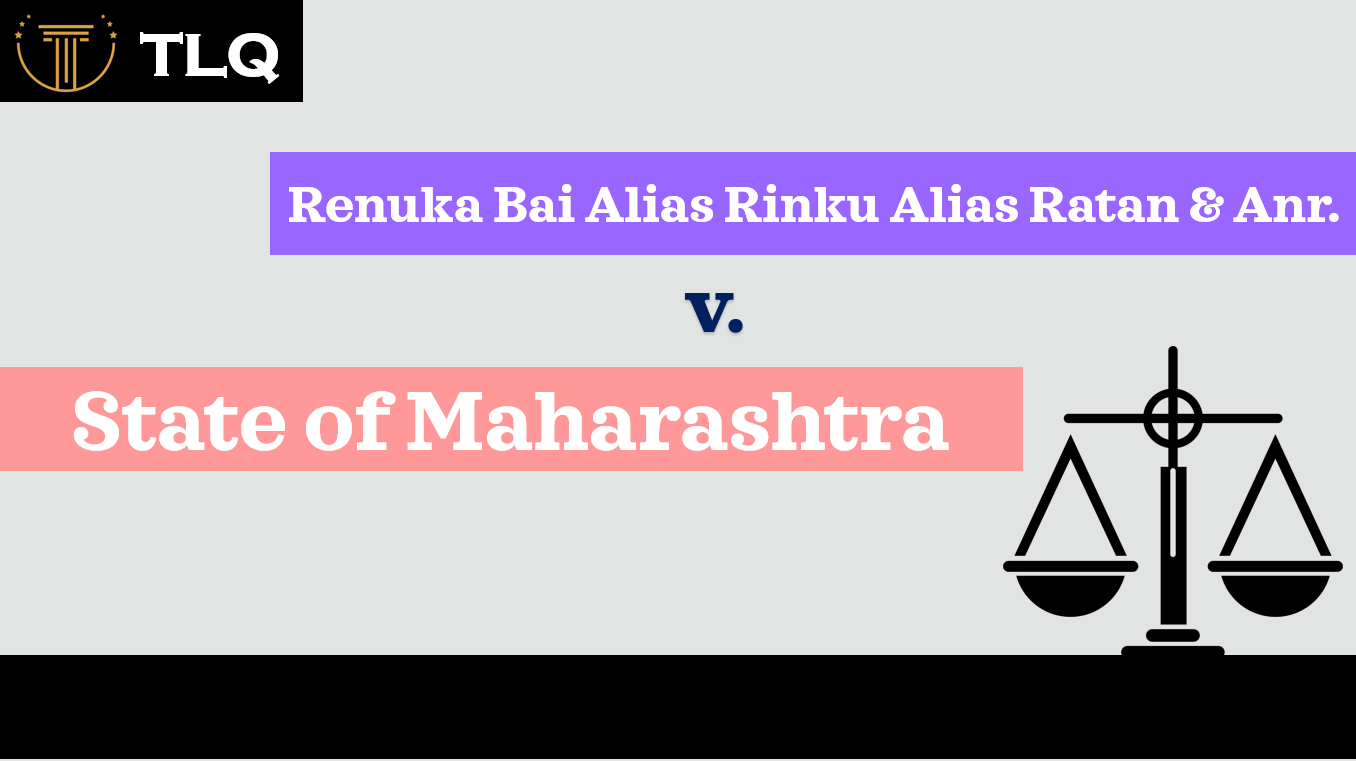Published On: 23rd April, 2024

Renuka Bai Alias Rinku Alias Ratan & Another… (Appellant)
Vs.
State Of Maharashtra… (Respondent)
Citation- AIR 2006 SUPREME COURT 3056.
Criminal Appeal No. 722 of 2005, decided on August 31, 2006.
Bench – K.G. Balakrishnan & G.P. Mathur.
Facts of the case
Renuka Bai, often referred to as Rinku or Ratan and Seema, also called Devki or Devli, are sisters. Anjanabai is their mother’s name. The sisters and their mother were thieves in the past. To do this, they would travel to locations where festivals were held. Whenever they had the chance, they would steal gold chains, and they would live off the money they acquired from these crimes. The tailor Kiran Shinde worked in a shop and was from Pune. Upon meeting Renuka Bai, he got married to her in December 1989 at a temple close to Shirdi. Renuka had previously been married to someone else, and the couple had a child named Aashish. These two sisters were renters in a Gonthalinagar, Pune, home with their mother Anjanabai, Kiran Shinde, and child Aashish.
Renuka Bai along with her child Aashish once visited a temple in 1990. At the temple, where there was a sizable crowd, Renuka Bai attempted to steal a purse from someone but was caught. Upon being caught, she let out a loud cry and asked the individual why he had grabbed her hand when she had her little child with her and couldn’t possibly be connected to any criminal activity. As a large crowd gathered around her, they saw the mother and the child and moved away from Renuka Bai. She described the story to her mother Anjanabai and sister Seema, explaining how she had escaped because the child was with her. The sisters and their mother made the decision to have a child with them at the crime scene going forward to use the kids as a means of escaping the crowds. Their mother Anjanabai teamed up with Kiran Shinde to abduct young children under the age of five, utilize them as needed, and then get rid of them when they were no longer needed. They believed that doing this was the only way to avoid being arrested if they were ever discovered stealing.
They abducted multiple children, and after they were no longer needed, they would horrifyingly kill the children by beating them, choking them, or throwing them from heights and dispose of their bodies. They used to get rid of some children in busy areas, bus stops, or temples by leaving them there. The prosecution claims that these sisters, along with their mother Anjana Bai and Renuka’s husband Kiran Shinde, had a hand in the kidnapping of 13 children, killing 9 of them. These offenses were reportedly all committed between June 1990 and October 1996. The four were found guilty on many counts, and the Sessions Court’s imposition of the death penalty was upheld by the High Court.
Legal issues
Renuka and Seema, who were convicted by the Bombay High Court of several offenses including conspiracy, kidnapping, and murder, have filed this criminal appeal. The appellants faced charges related to multiple offenses that they were purportedly involved in between June 1990 and October 1996. Following their trial by Additional Sessions Judge Kolhapur, they were found guilty and given the death penalty. The conviction on multiple counts and the sentence handed down were upheld by the High Court. After carefully examining the prosecution’s evidence, the Sessions Judge rendered a comprehensive decision finding the appellants guilty of most of the charges brought against them. In most of the cases, the High Court upheld the verdict. Despite the appellants being charged with nine murders, the Sessions Court only found them guilty of six killings. The prosecution could only establish five counts of murder against these appellants, the High Court ruled when the case was brought up for appeal. The appellants were found guilty of murder by the trial court in the deaths of Santosh, Anjali, Raja, Shraddha, Gauri, and Pankaj. Nonetheless, the High Court determined that the evidence was insufficient to prove Raja’s murder. In each of these cases, the appellants entered a not guilty plea and claimed that their accusations against them were unfounded. The appellants were found guilty of the crime covered by Section 302 read with Section 120B of the Indian Penal Code, and as a result, they were sentenced to death.
On October 17, 1997, Kiran Shinde became an approver. The magistrate examined him for the first time on September 17, 1998. Kiran Shinde was granted a pardon under Section 306 of the Code of Criminal Procedure after he became an approver. He was then questioned as a witness for prosecution under Section 308 of the Code of Criminal Procedure.
Arguments of the parties
The Petitioners filed Criminal Appeal No. 718 of 2001 with the High Court. While in detention, Anjanabai, mother of appellant passed away. Kidnapping children and using them as tools for theft is a criminal conspiracy. On August 31, 2006, the Criminal Appeal No. 722 of 2005 that the Petitioners had filed with the Supreme Court was dismissed, and the death sentence was upheld. On August 17, 2013, the Maharashtra Governor denied the application of a mercy appeal that sought to use Article 161 of the Indian Constitution to grant a pardon. On July 30, 2014, the President of India denied an application to use Article 72 of the Indian Constitution to grant a pardon.
On August 19, 2014, the day the petitioners were scheduled to be executed, the petition was moved urgently. Following the Superintendent of Jail’s telephone directive that the execution would not proceed, the Public Prosecutor delivered a statement. On the next date, the Petition remained on file. Hearings on the Petition were held August 20, 2014. Following orders from Mr. Deepak Jadiye, Section Officer, Home Department, the learned Public Prosecutor spoke on behalf of the State, stating that the death penalty would not be carried out while the Petition was pending. Consequently, the life sentences of Renuka Kiran Shinde and Seema Mohan Gavit, the petitioners, were commuted to death sentences. The warrant for the execution of the petitioners’ death sentence is revoked and set aside because it was not carried out while the petition was pending and being heard.
Holding
The sisters were convicted by the Sessions Court in Kolhapur in 2001 of abducting thirteen and killing six children. In 2004, the Bombay High Court confirmed the verdict, but they were found not guilty of one murder. The death penalty imposed by these courts was upheld in 2006 by the Supreme Court. Following this decision, Seema and Renuka submitted requests for mercy in 2008 and 2009, respectively. President Pranab Mukherjee denied their requests in 2014. In 2022, the Bombay High Court modified their execution sentence to life in prison due to the delay in seeking a ruling on their mercy appeals. At present, the sisters remain imprisoned at Pune’s Yerwada Jail. The sisters would have been the first women to be executed in India since 1955 if their original sentences had been carried out.
Reasoning
Every ruling made by the court is supported by sound logic. The court delivers its decision only after conducting a thorough inquiry and considering all available facts. A thorough inquiry aids the court in applying the provisions designed for different types of offenses. It makes sure judges make the proper decisions. Both the high court and the supreme court have thoroughly examined all relevant facts and evidence in this case. The court has rendered decisions with the assistance of eyewitnesses and evidence that has been corroborated with the approver’s information.
As a result, the prosecution was successful in establishing the appellants’ history of killing children. The appellants’ learned counsel argued persuasively before us that the approver’s testimony was tainted, and the court should not have accepted it. The High Court was right in ruling that the approver had withheld certain elements of the crimes. Despite the two appellants’ recurrent criminal activity, the approver moved in with them for a considerable amount of time without reporting anything to the police or other authorities. The approver and the appellants shared custody of some of the children who had been abducted by them; subsequently, the bodies of those children were discovered. In one instance, the postmortem investigation revealed that the child had experienced an abnormal offense. The approver acknowledged that he had repeatedly bought off the police to keep these appellants out of trouble. The public prosecutor had not taken any action to prosecute the approver despite all these shocking disclosures, and the approver could not be prosecuted. We believe that in these kinds of situations, the court itself has the right to act against the approver if it is knowingly hiding important information or providing misleading testimony.
The appellants were found guilty of these murders and were given the death penalty; the High Court upheld their sentence. Based solely on the case file, Court do not see any favourable mitigating factors for the appellant other than that they are women. Furthermore, the nature of the crime and the methodical manner in which each kidnapping and murder occurred clearly show how depraved the appellants’ minds were. These appellants engaged in illegal activity for a very long time, up until the point at which the police caught them. They carried out their plans to kidnap the kids very cunningly, and when the kids were no longer needed, they killed them and threw their bodies into a remote area. Despite not being under any compulsion, the appellants murdered all these children with little regard for the children’s lives or their parents’ suffering.
Conclusion
According to a police detective, all three of them were difficult to crack. He said, “They would sit there and look. Never once did they crack”. This illustrates that these people were not mentally stable. Some babies were abandoned by them, some were killed when they were no longer needed, and still others were purposefully hurt to divert attention. After the theft was successfully carried out, the sisters ruthlessly exceeded their mother by hurling the newborns downstairs, beating them against electric poles, hanging them upside down from ceilings, and even slicing up their bodies. There are many faces to horror, and the worst of them is everyday life. The sisters appeared to be typical middle-class girls going about their daily business. They are much more dangerous and unpredictable since it is easy to become lost in the mob. An ordinary person could never conceive such wickedness lurking around, ready to murder their loved ones in cold blood. Considering all the information, the only thing that crosses everyone’s mind is that these people don’t deserve to live. Nobody can possibly imagine the suffering small kids must have gone through due to the heinous and despicable deed these people committed. These people are equivalent to monsters. We therefore see nothing wrong with the court’s decision to sentence these individuals to death. Following the decision, KG Balakrishnan and GP Mathur’s Supreme Court bench made the following remarks: “They had been a menace to society, and people in these cities were horrified, and they could not even send their children to schools. One would hardly have expected such barbarity from women.”





